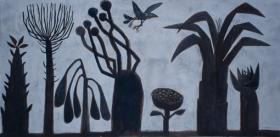Petrus De Man "Jadis les arbres étaient des gens comme nous"
"Before, the trees were people like us"
Monumental, rude, jerky and spasmodic, its characteristics define the house as an islet of alienation. A little man inhabits the rudimentary, lopsided polyhedron which is divided into sections, or holds it at arm’s length, uncertain as to what to do with it. Which one contains the other? Too big for his tight-fitting suit, his “environment”, our little man scrunches up, feels the pressure of the walls, bursts forth from them, makes them his own. All things in this singular universe—man-child, home-cage, trees, flowers and sun, all solidified—share the same imperfect, wide open geometry with broken corners. Infantile, sorrowful, pathetic, from the very beginning Petrus De Man’s representations oscillate between the damaging of the Cycladic idol, Permeke’s modernism, and the constructive abstraction of the Flemish artists Luc Claus and Dan Van Severen. But clearly, for him, the gods have fallen on their heads. And if the visual artist progressively reaches other, more monumentally malleable shores, he still plays with liberty and derision to attack rigidity and all forms of confinement.
A far cry from the dreamy haze, the shiver of repentance, the denial of male chauvinism, the barracks lament of yesterday. The long sob of the naked man, reclining or upright, from the front or the back, often duplicated, dragging along a sidekick or a reluctant brat, lasted for some time. Imitating the geometry of the early years more frankly, Petrus has traded the obsession with siblings and secrecy for a less sentimental form of expression. The horizon broadens, landscapes are born, flowers, sun, trees, so many terms aligned in a crude and baroque equation. The problem seems to be clearer. There is this, that, and himself, Petrus, in the centre. Art is there to denominate, not to resolve. Square and cylindrical forms bloom, trees with trunks as thick as flower pots hold out their arms of cast iron. The stroke is brutal, powerful, as though the artist had initially forged the steel, interiorizing the lesson of the hard lines born of the shock of matter and elements. And yet, of metal, Petrus knows only the plaque for engraving, the rudimentary and difficult point and the drawing that is the result, charcoal, pastel, infused with anger and anguish. An abrupt drawing, broken and yet energetic, whose emotional power—Petrus always knew it—must be preserved at all costs.
Danièle Gillemon, art critic and journalist of Le Soir.
April 2009
